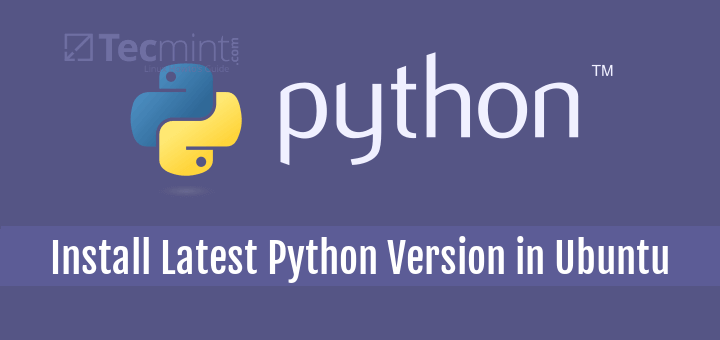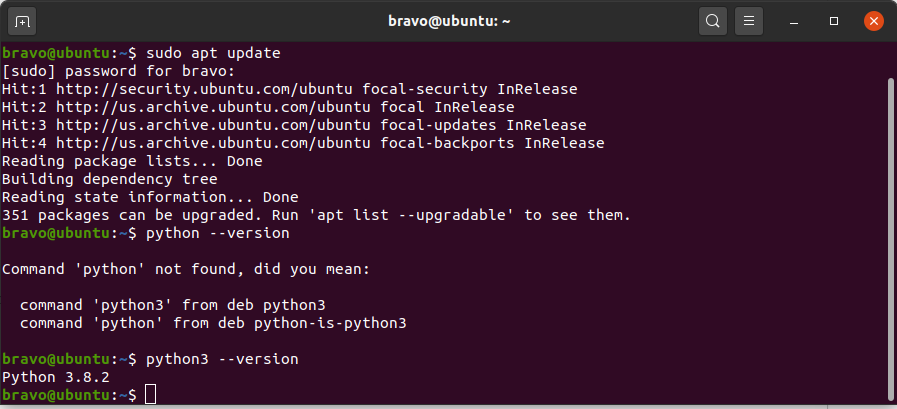

- Linux install python 3.6 from terminal full#
- Linux install python 3.6 from terminal windows 10#
- Linux install python 3.6 from terminal download#
- Linux install python 3.6 from terminal mac#
Linux install python 3.6 from terminal windows 10#
Linux install python 3.6 from terminal full#
It is recommended, but not required, that your Windows system has an NVIDIA GPU in order to harness the full power of PyTorch’s CUDA support. Depending on your system and compute requirements, your experience with PyTorch on Windows may vary in terms of processing time. PyTorch can be installed and used on various Windows distributions. Here we will construct a randomly initialized tensor. To ensure that PyTorch was installed correctly, we can verify the installation by running sample PyTorch code. Then, run the command that is presented to you. Often, the latest CUDA version is better. To install PyTorch via pip, and do have a CUDA-capable system, in the above selector, choose OS: Linux, Package: Pip and the CUDA version suited to your machine. To install PyTorch via pip, and do not have a CUDA-capable system or do not require CUDA, in the above selector, choose OS: Linux, Package: Pip and CUDA: None. To install PyTorch via Anaconda, and you do have a CUDA-capable system, in the above selector, choose OS: Linux, Package: Conda and the CUDA version suited to your machine.


To install PyTorch via Anaconda, and do not have a CUDA-capable system or do not require CUDA, in the above selector, choose OS: Linux, Package: Conda and CUDA: None. Tip: If you want to use just the command pip, instead of pip3, you can symlink pip to the pip3 binary. If you decide to use APT, you can run the following command to install it: However, if you want to install another version, there are multiple ways: If you want to use just the command python, instead of python3, you can symlink python to the python3 binary. Tip: By default, you will have to use the command python3 to run Python.

Python 3.7 or greater is generally installed by default on any of our supported Linux distributions, which meets our recommendation. The specific examples shown were run on an Ubuntu 18.04 machine. An example difference is that your distribution may support yum instead of apt. The install instructions here will generally apply to all supported Linux distributions. PyTorch is supported on Linux distributions that use glibc >= v2.17, which include the following: Prerequisites Supported Linux Distributions It is recommended, but not required, that your Linux system has an NVIDIA GPU in order to harness the full power of PyTorch’s CUDA support. Depending on your system and compute requirements, your experience with PyTorch on Linux may vary in terms of processing time. PyTorch can be installed and used on various Linux distributions. If you use the command-line installer, you can right-click on the installer link, select Copy Link Address, and then use the following commands:
Linux install python 3.6 from terminal download#
To install Anaconda, you can download graphical installer or use the command-line installer. Anaconda is the recommended package manager as it will provide you all of the PyTorch dependencies in one, sandboxed install, including Python. To install the PyTorch binaries, you will need to use one of two supported package managers: Anaconda or pip. It is recommended that you use Python 3.7 or greater, which can be installed either through the Anaconda package manager (see below), Homebrew, or the Python website. PyTorch is supported on macOS 10.10 (Yosemite) or above.
Linux install python 3.6 from terminal mac#
It is recommended, but not required, that your Mac have an NVIDIA GPU in order to harness the full power of PyTorch’s CUDA support.Ĭurrently, CUDA support on macOS is only available by building PyTorch from source Prerequisites macOS Version Depending on your system and compute requirements, your experience with PyTorch on a Mac may vary in terms of processing time. PyTorch can be installed and used on macOS.


 0 kommentar(er)
0 kommentar(er)
